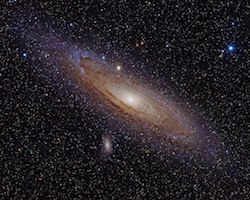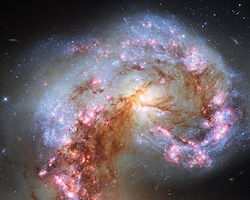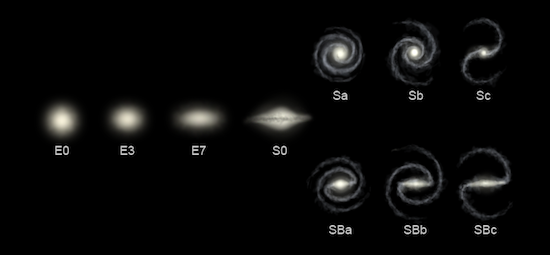
Gigantic Groups of Galaxies
 If you had a rocket ship, where would you go? Past the moon? Past all the planets in our solar system? Maybe even outside of our galaxy, the Milky Way? What would you find out there?
If you had a rocket ship, where would you go? Past the moon? Past all the planets in our solar system? Maybe even outside of our galaxy, the Milky Way? What would you find out there?
It turns out you would find millions more galaxies like our own Milky Way. They don’t all look like the nice galaxy that we call home, in fact they come in all sorts of shapes and sizes.
The Gravity of Galaxies
You’ve probably been told “What goes up must come down”. When you throw a ball up into the air, it comes back down. This is because the gravity of Earth pulls the ball down toward the ground. Galaxies have their own gravity that acts in the same way.
Galaxies are huge collections of stars that are all pulled together by gravity. This gravity keeps stars, gas, and dust all grouped together. In the same way that gravity on Earth pulls on the ball, the stars are constantly being pulled toward the center of the galaxy.
 We can see these galaxies from Earth. When you go outside and look up at the sky on a clear night, you can probably see hundreds or thousands of small points of light. Most are stars just like our sun, some are planets, but others are galaxies containing billions of stars. Astronomers used telescopes to look closer at these galaxies and found that not all galaxies look the same. To be able to compare new galaxies to old ones, they began to classify them into different groups.
We can see these galaxies from Earth. When you go outside and look up at the sky on a clear night, you can probably see hundreds or thousands of small points of light. Most are stars just like our sun, some are planets, but others are galaxies containing billions of stars. Astronomers used telescopes to look closer at these galaxies and found that not all galaxies look the same. To be able to compare new galaxies to old ones, they began to classify them into different groups.
Hardworking Hubble
Edwin Hubble (1889-1953) started to organize galaxies into what is called the “Hubble Sequence”. Edwin was one of the first people to notice that some of the points of light we see in the sky are actually distant galaxies. After studying pictures of these galaxies, he began to see patterns. He formed three groups of galaxies: elliptical, spiral and irregular.
In the same way you can pick out a series of colors between red and blue, Edwin noticed a series of galaxies that were related by their shapes. Take a look at the diagram below, does it look like one galaxy is shifting into another?
On the left are elliptical galaxies; they are recognized by the fact that they are circular blobs of stars. Moving to the right, the blobs start to have more shape until you see a pinwheel shape. This shape is from the spiral arms, which is why we call these galaxies spiral galaxies. What if a galaxy doesn’t look like any of these? Those are called irregular galaxies.
There are other shapes such as ring and lenticular. There are even smaller galaxies known as dwarf galaxies. However elliptical, spiral, and irregular are the most common.
Grouping and Regrouping Galaxies
For a while, astronomers thought there might be a connection between the shapes. Maybe as galaxies age, they turn from one shape to another, moving along the sequence. Would it be possible for one galaxy to look like each shape throughout its lifetime?
 It turns out that this might be true. By looking at what color the galaxies are, astronomers are able to estimate how the age of the galaxies. It appears that spiral galaxies are young with many hot blue stars in them and ellipticals are old and full of old red stars.
It turns out that this might be true. By looking at what color the galaxies are, astronomers are able to estimate how the age of the galaxies. It appears that spiral galaxies are young with many hot blue stars in them and ellipticals are old and full of old red stars.
So how do we decide what type a galaxy is? The same way Edwin Hubble did. Astronomers look at pictures of galaxies and look for special features - like spiral arms - to classify new galaxies. However, sometimes galaxies can be given the wrong label. As our pictures get better and we learn more about each type of galaxy, astronomers can re-classify galaxies if they seem to no longer fit into the shapes Edwin Hubble first noticed.
Additional images via Wikimedia Commons. Image of Hubble Telescope by NASA.
Bibliographic Details
- Article: Gigantic Groups of Galaxies
- Author(s): J’Neil Cottle
- Publisher: Arizona State University Learning Enterprise Ask An Earth & Space Scientist
- Site name: ASU - Ask An Earth And Space Scientist
- Date published:
- Date modified:
- Date accessed: May 7, 2025
- Link: https://askanearthspacescientist.asu.edu/explore/galaxies
APA Style
J’Neil Cottle. (). Gigantic Groups of Galaxies. Retrieved {{ nothing_3 }}, from {{ view_node }}
American Psychological Association, 6th ed., 2nd printing, 2009.
For more info, see the
APA citation guide.
Chicago Manual of Style
J’Neil Cottle. "Gigantic Groups of Galaxies." ASU - Ask An Earth And Space Scientist. Published . Last modified . https://askanearthspacescientist.asu.edu/explore/galaxies.
Chicago Manual of Style, 17th ed., 2017.
For more info, see the
Chicago Manual citation guide.
MLA Style
J’Neil Cottle. Gigantic Groups of Galaxies. ASU - Ask An Earth And Space Scientist. , {{ view_node }}. Accessed 2025, May 7.
Modern Language Association, 8th ed., 2016.
For more info, see the
MLA citation guide.

The Hubble Telescope orbits Earth, taking pictures of bodies in space, such as galaxies. Sitting beyond our atmosphere, it can get some of the clearest images we have of far away galaxies.
Be Part of
Ask An Earth and
Space Scientist
By volunteering, or simply sending us feedback on the site. Scientists, teachers, writers, illustrators, and translators are all important to the program. If you are interested in helping with the website we have a volunteers page to get the process started.

